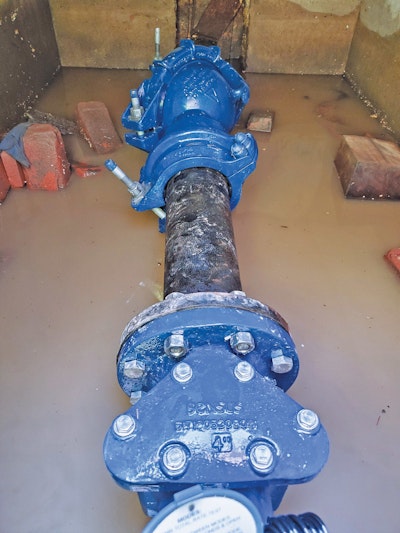
While trying to install a new meter in an underground concrete vault, Cumberland (Maryland) Water Department employees found the line coming out of the vault was offset from the feeder line. An old coupling, fashioned from poured lead, had been used to correct the misalignment many years ago.
Interested in Infrastructure?
Get Infrastructure articles, news and videos right in your inbox! Sign up now.
Infrastructure + Get AlertsFrom rerouting old water pipes to connect with newly laid lines or replacing things like underground water meters and valves, it’s a fact of life that underground pipes don’t always align perfectly. In many cases, the only question at that point is how much excavation will be required to give pipes enough play to nudge them into alignment.
But at the Cumberland Water Department in the city of Cumberland, Maryland, misaligned pipes are no longer an expensive, time-consuming issue, thanks to HYMAX SwivelJoint fittings, says Marty Watts, assistant superintendent.
The utility has installed six SwivelJoints since early 2020 and Watts estimates they’ve saved the city tens of thousands of dollars in labor costs. They also help the utility provide better customer service because water outages don’t last as long, which reduces stress on the utility’s staff.
“Water outages have a trickle-down effect, from the guys out in the field all the way to our office, where people handle all the phone-call complaints from customers,” Watts explains. “The SwivelJoints help everybody in our department out a little bit. They’ve come in quite handy for us.
“They definitely put a lot of thought and ingenuity into this coupling in order to make our lives in the water business just a little bit easier,” he adds.
The Cumberland water utility has about 10,000 customers. The water system includes roughly 180 miles of pipe, ranging in size from 2-inch-diameter service lines to 36-inch transmission lines. The pipes are made of cast iron, ductile iron, concrete, copper and plastic.
“It’s an eclectic mixture,” Watts says.
Flexible connection
Made by Krausz Industries, the SwivelJoint can connect two pipes at any angle from zero to 90 degrees. It can accommodate pipes from 4, 6, 8, 10 and 12 inches in diameter and can join pipes made of metal or plastic.
As its name implies, one of the SwivelJoint’s two stab-fit couplings rotates. In a nutshell, the installer attaches the fixed end of the coupling to one of the pipe ends until it meets the minimum stab depth (indicated on the product’s label), then swivels the other coupling until it aligns and can be slid onto the end of the other pipe.
After that, installers must use a torque wrench to tighten a central locking bolt to the correct torque (again, provided on the product’s label), then the two other bolts. Then they need to recharge the line and check for leaks.
Gripping teeth in the couplings, each of which feature a hydraulically assisted gasket with two-stage sealing, grab onto the pipe ends and prevent them from sliding. In addition, a radial gripping system prevents pipe motion.
The swivel joint allows for 4 degrees of deflection per coupling, which helps it withstand shifting soils. In addition, it can even adapt to pipes out-of-round by up to 0.16 inches, as well as withstand working temperatures as low as negative 20 degrees and as high as 125 degrees.
“Installation is as simple as simple can get,” Watts says. “You can show someone how to install one in less than 10 minutes. Anyone who can tighten a wrench can install one.”
Labor-saving device
A recent project underscores the SwivelJoint’s value. While trying to install a new meter in an underground concrete vault, city employees found the line coming out of the vault from the meter was offset from the feeder line. An old coupling, fashioned from poured lead, had been used to correct the misalignment years and years ago, Watts explained.
Connecting any new pipes at this unusual, offset angle would’ve been tricky because there was little room to add extra piping within the vault, and the pipe that went through the vault wall could not be shifted.
As such, aligning the pipes would require manipulating the feeder pipe. That, in turn, would require additional excavation around the feeder pipe in order to give workers enough play to realign the two pipes and install a new coupling, Watts says.
But that’s where the SwivelJoint came in.
“Instead of having to expose, say, 15 to 20 feet of pipe, we only had to expose 6 to 8 feet,” he says. “We would’ve needed a day of prep time and then would’ve had to shut off water to about 200 people living nearby for about four to six hours.
“But instead, we used the SwivelJoint to replace the old coupling and finished the entire job in under 4 hours,” he continues. “Customers were without water for only an hour or two. Overall, there was a significant savings in terms of time, labor and customer complaints.”
Good return
The water department keeps 6- and 8-inch diamter SwivelJoints in stock because those are the most common pipe sizes in the system. The cost is roughly $1,300 for a 6-inch coupling and about $1,800 for an 8-inch unit.
“The times when we find pipes that are badly misaligned are far and few between,” Watts says. “But it happens often enough that we keep two in stock. We never know what’s underground until we dig it up.
“We don’t want to put things back in the ground partial or just try to make do because ultimately, we’re the ones who have to go back and fix things if the repair doesn’t hold,” he adds. “So we want to do things right the first time, and the SwivelJoint helps us do that.
“Sure, the fittings are a little bit pricier, but they more than pay for themselves through reduced labor costs.”






